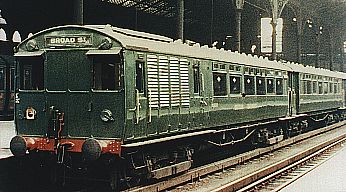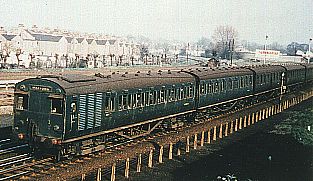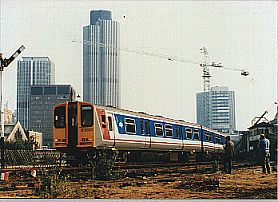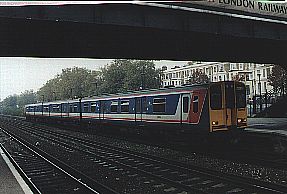
Suburban Electric Railway Association
Located at the COVENTRY ELECTRIC RAILWAY CENTRE, Rowley Road, Baginton, Warwickshire
Established
1996
The History Zone
History of North London DC Services
Part Three
The British Railways Era
1948 - 1995
|
After the relative stability of the pre-war LMS years the next decades in the lives of North London Electric railways were to see massive changes, to both the services and the trains themselves.The first change was that the LMS maroon of the electric units gave way to the British Railways colour scheme of malachite green. The size of the network was reduced when passenger services were totally withdrawn from the Watford - Rickmansworth branch in March 1952. By 1959 The services on the Croxley Green branch ran during peak hours Monday to Friday only. New units were built for the routes in 1957, the class 501s (detailed on a separate page), the LNWR Oerlikon stock vanished by 1960 with the LMS GEC units lasting only a couple of years more. In 1970 the whole system was altered to operate without the negative return rail, instead the current return was made through the running rails, the 4th rail was left in place bonded to the running rails on most routes as underground stock that shared the lines still operated on that principle. A change of colour scheme from green to blue and then from blue to blue and grey took place over the next 12 years along with further reductions in the number of trains on the remaining routes. In 1985 the 501 units were replaced by class 313 units drafted in from North East london suburban lines. The 313s were built between 1976 and 1977 at BRs York works. They were able to operate from both DC conductor rails and AC overhead live wires. Each three car unit was formed of two driving motors with a pantograph trailer in between. The styling was a generation removed from that of the 501s with open saloon layouts, air operated sliding doors, fluorescent lighting and metal and plastic interior fittings. The most dramatic change to take place in 1985 was the extension of the Richmond route electrification out, via Stratford, to North Woolwich in East London. This meant the end for Broad Street station which closed in June the following year. The long established depot at Croxley Green that had been responsible for all the day to day maintenance on North London electric units since the days of the LNWR was also closed in November 1985 as the 313 units were to be maintained at Eastern Region depots. Late in 1985 all services in London and the South East were re-branded under the Network SouthEast name. This meant a new livery of red, white, blue and grey started to replace the blue and grey on the 313 fleet. The new colours even extended to station nameboards, lamposts and litter bins ! In 1988 an attempt was made to revive the Croxley Green branch with a twice hourly daytime service. The experiment was abandoned in 1990 and the branch service went rapidly downhill, the last level of service was one early morning return working from Watford Junction on weekdays only, in recent years this single return trip has been worked by a taxi cab as the junction with the Euston Line has been severed and some of the track on the branch has been lifted. A new service was introduced in 1994 from Willesden Junction to Clapham Junction, via Kensington Olympia, the service was initially provided by diesel units for the first 18 months until a short spur was electrified to permit use of 313 units. This service was a close copy of the original LNWR service that ran from Willesden Junction to Earls Court from 1914 until 1939. By 1996 the routes had been branded under the North London Railways name along with the outer suburban AC electric services that ran from Euston to Milton Keynes and Northampton. Like all the other passenger franchises North London Railways was offered to the private sector to manage that same year, thus another chapter of the life of the North London electric suburban lines began. |
|
|






